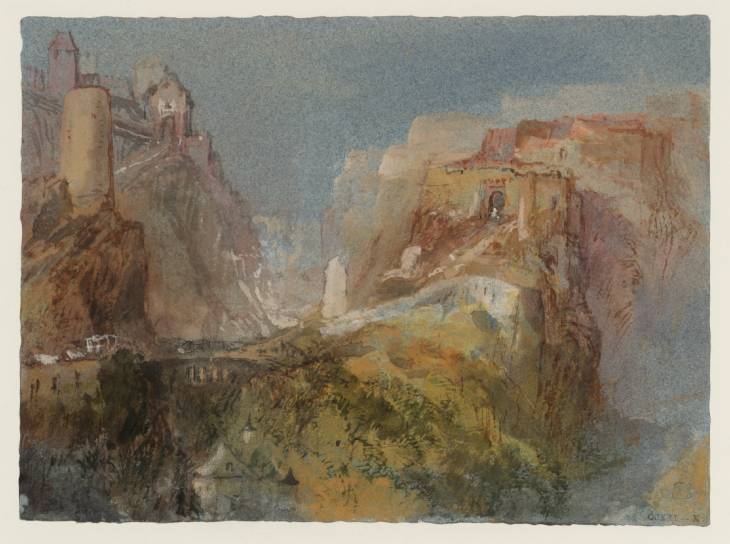Joseph Mallord William Turner The Rham and the Bock, Luxembourg c.1839
Joseph Mallord William Turner,
The Rham and the Bock, Luxembourg
c.1839
Joseph Mallord William Turner 1775–1851
The Rham and the Bock, Luxembourg c.1839
D20244
Turner Bequest CCXXI K
Turner Bequest CCXXI K
Gouache, pen and ink and watercolour on blue wove paper, 140 x 190 mm
Blind-stamped with Turner Bequest monogram bottom right
Stamped in black ‘CCXXI–K’ bottom right
Blind-stamped with Turner Bequest monogram bottom right
Stamped in black ‘CCXXI–K’ bottom right
Accepted by the nation as part of the Turner Bequest 1856
Exhibition history
1904
National Gallery, London, various dates to at least 1904 (186, as ‘Luxembourg?’).
1959
Turner Watercolours from the British Museum, Luxembourg State Museum, June–July 1959 (no catalogue).
1984
J.M.W. Turner in Luxembourg and its neighbourhood, Musée de l’Etat, Luxembourg, March–April 1984 (17, reproduced, also p.35 and in colour [p.16] as Vue de Luxembourg: la montée du Bock depuis Clausen).
1995
J.M.W. Turner: The Luxembourg Watercolours: Collections de la Tate Gallery, Londres et du Musée national d’histoire et d’art, Luxembourg, Musée national d’histoire et d’art, Luxembourg, January–February 1995 (12, reproduced in colour [also p.16] as Vue de Luxembourg: la montée du Bock depuis Clausen).
References
1904
E.T. Cook and Alexander Wedderburn eds., Library Edition: The Works of John Ruskin: Volume XIII: Turner: The Harbours of England; Catalogues and Notes, London 1904, pp.386, 616 no.186, as ‘Luxembourg?’.
1909
A.J. Finberg, A Complete Inventory of the Drawings of the Turner Bequest, London 1909, vol.II, p.688, as ‘Luxembourg (?)’.
1984
Gérard Thill, Jean-Claude Muller and Jean Luc Koltz, J.M.W. Turner in Luxembourg and its neighbourhood, exhibition catalogue, Musée de l’Etat, Luxembourg 1984, pp.24, and note 33, [p.31], 29, and note 41, [p.31].
1991
Cecilia Powell, Turner’s Rivers of Europe: The Rhine, Meuse and Mosel, exhibition catalogue, Tate Gallery, London 1991, p.181.
Here Turner depicts the Rham and the Bock at Luxembourg, two vertiginous plateaux carved by the meanderings of the Alzette River. The watercourse itself is not shown owing to Turner’s choice of viewpoint here, but the artist does suggest the dense mist and spray rising from the river up through the deep and narrow gorge in the foreground. Obscuring smudges of violet, blue-grey, and dark green signify this mist as well as suggesting the long and shadowy drop to the base of the ravine. These rather dim tones are contrasted with those used to render part of a hillside at the top of the gorge which juts towards the viewer at the centre of the foreground. This section of land is lushly verdant: coloured in brighter opaque ochre and green gouache.
Luxembourg City’s unusual yet strategically advantageous topography of deep gorges and high plateaux afforded it significant defensive position. Over centuries the Bock promontory, shown in this drawing at centre, has been fortified, attacked, reinforced, besieged, and rebuilt by a host of powerful European armies. The Burgundians, Hapsburgs, Spanish, Prussians, and French have all vied for the Fortress of Luxembourg, one of the continent’s most strategic strongholds. Its foundations are Roman, yet it was not until the tenth century that a castle was constructed on the site by Count Siegfried.1 During the sixteenth and seventeenth centuries, Luxembourg changed hands a number of times between French and Spanish occupation, with each side contributing to the remodelling of the fortification. In the 1680s, for example, the complex was enlarged and strengthened by Vauban, chief military engineer to King Louis XIV.2 To the left of the Bock in Turner’s drawing is the wall-girdled Rham, its ramparts punctuated with towers and gateways. Vauban also fortified this promontory, constructing new military barracks to house a more expanded French garrison.
This gouache is taken from a similar vantage point to Tate D20245; Turner Bequest CCXXI L, but here Turner is closer in distance. For other of Turner’s Luxembourg gouaches see Tate D20245–D20249, D20264, D20270, D20272–D20273, D20284–D20285, N05240; Turner Bequest CCXXI L–CCXXI P, CCXXII E, CCXXII K, CCXXII M–CCXXII N, CCXXII Y–CCXXII Z.
Verso:
Inscribed in chalk ‘x’ and ‘5’ at top towards right; inscribed in pencil ‘15 b’ at centre towards top left and ‘32b’ at centre towards right; stamped in black with Turner Bequest monogram and ‘CCXXI K’ at centre towards bottom; inscribed in pencil ‘CCXXI K’ at bottom centre.
Alice Rylance-Watson
June 2013
How to cite
Alice Rylance-Watson, ‘The Rham and the Bock, Luxembourg c.1839 by Joseph Mallord William Turner’, catalogue entry, June 2013, in David Blayney Brown (ed.), J.M.W. Turner: Sketchbooks, Drawings and Watercolours, Tate Research Publication, November 2014, https://www

